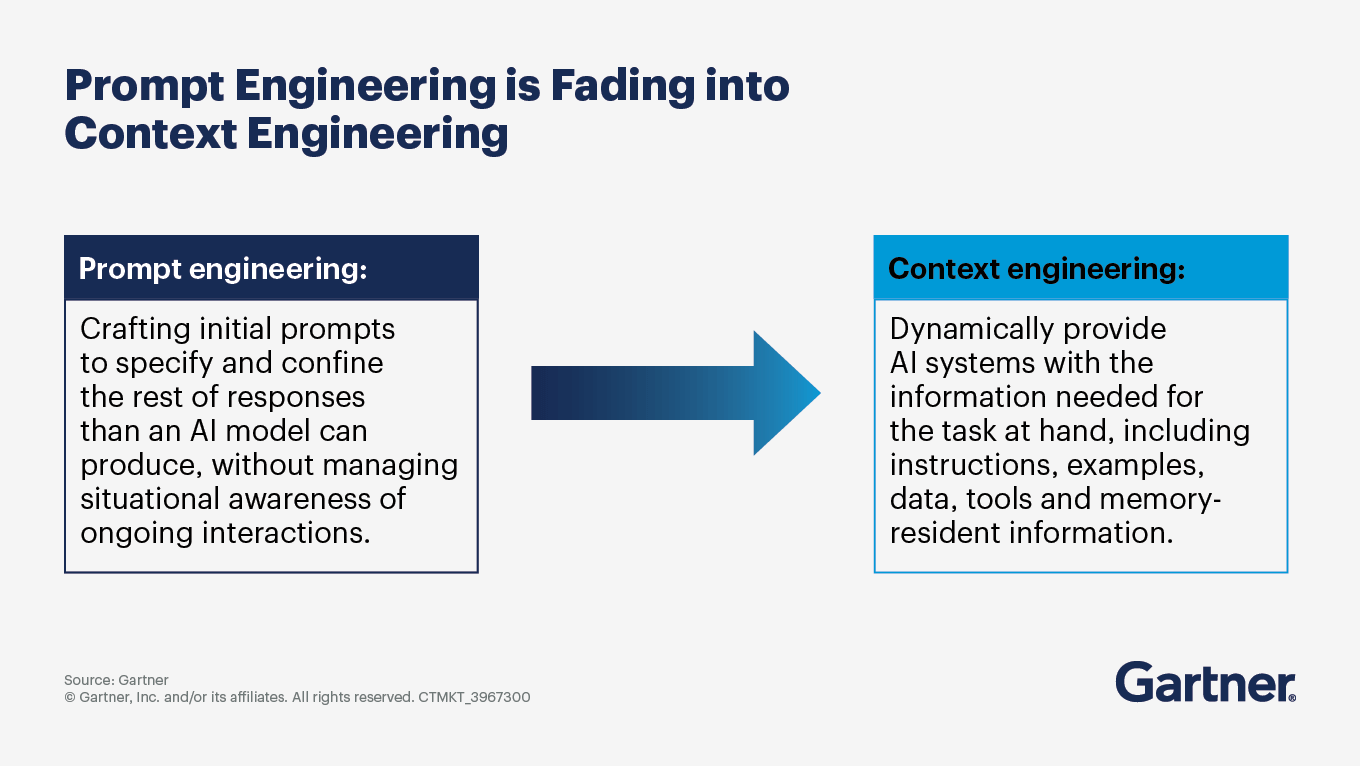It’s time to prioritize context over prompts with context-aware architectures, dynamic data and reimagined human-AI interfaces.
- Gartner client? Log in for personalized search results.
Complete the picture by adding context for smarter AI
There’s a huge gap between today’s AI –– prone to hallucinations and incomplete results –– and the powerful, all-knowing AI of futuristic science fiction. The difference is a matter of dimension. Context adds depth, transforming AI from that of a black-and-white comic strip into a 3D virtual world.
Today’s AI lacks information breadth and depth — the details humans take for granted. For people, context includes tone of voice, facial expression and body language. For AI, this means specific data and tools tailored to a specific task vs flooding it with irrelevant details.
If you’re serious about AI, make context engineering a strategic priority
Context is key to achieve scalable, adaptive high-impact enterprise AI.
What is context engineering?
Gartner defines context engineering as designing and structuring the relevant data, workflows and environment so AI systems can understand intent, make better decisions and deliver contextual, enterprise-aligned outcomes — without relying on manual prompts.
Gartner research backs up the trend toward curating, controlling and evolving context to improve AI results:
Tailored solutions that use contextual information, not just prompts, yield higher GenAI productivity gains.
Organizations are shifting to specialized applications that integrate deeper levels of data and logic, reducing reliance on generic prompts.
Consumers’ concerns about AI-driven misinformation highlights the urgent need for accurate situational awareness.
Agentic AI suffers high failure rates due to misalignment and poor coordination. Context engineering addresses this by curating and sharing dynamic contexts and managing persistent contexts — which prompt engineering is incapable of.
Get strategic with context engineering
Only by making context engineering a strategic priority can you keep your organization’s AI systems relevant, adaptive and aligned with business goals. Surpass the constraints of prompt engineering by making sure context engineering is a core enterprise capability. Gartner recommends that AI leaders:
Appoint a context engineering lead or team and integrate the context engineering function with the AI engineering and operational governance (TRiSM) teams.
Set up organizational accountability, processes and technologies for curating, governing and evolving the context AI systems use to make decisions.
Invest in context-aware architectures that integrate data and signals from across the business. Ensure that context is continuously updated and validated.
Develop a roadmap for enterprise-wide context governance that spans data sources, knowledge graphs, policy frameworks and dynamic memory management.
Design AI solutions for dynamic, multimodal context integration
AI systems must generate outputs that are sophisticated, reliable and accurate. To accomplish this, feed AI a wide range of inputs that allow it to interpret a spectrum of nuanced signals — from structured databases to unstructured text, sensor data and real-time events and information feeds.
Static or siloed information won’t cut it. Instead, design AI solutions that can integrate multiple context types. This prevents information overload and information silos — especially in complex environments. Cross-modal synchronization lowers failure rates and supports deeper contextual insights that lead to better informed reasoning. The result is AI that responds with precision and agility as situations evolve, orchestrating relevant and compliant actions.
Gartner recommends that AI leaders:
Use flexible data pipelines and context fusion techniques that allow AI to draw from diverse sources.
Prioritize interoperability and real-time context updates.
Pilot multimodal context integration in high-impact use cases.
Context is constantly changing, so keep AI current
Context is fluid; that’s what makes it so complex and difficult to communicate to AI. Not only is it a moving target, but the sources of context data — business environments, regulations and user needs — are not factors that AI leaders have control over. That’s why AI leaders must put mechanisms in place for ongoing context evolution including feedback loops, monitoring and human-in-the-loop oversight. This ensures AI systems can adapt to new realities, maintain compliance and deliver sustained value.
Gartner recommends that AI leaders:
Implement continuous context monitoring and feedback processes.
Regularly review and update context information pipelines and processes.
Incorporate user and stakeholder input.
Use automated tools to detect drift or situational awareness gaps.
Context engineering FAQs
What are the benefits of context engineering?
As prompt engineering fades into tooling and templates, enterprises face the deeper challenge of giving AI systems the right situational awareness to act with relevance and precision. That’s where context engineering steps in — orchestrating actions, enforcing policy, managing memory-resident information and tailoring outputs all depend on what AI knows at any given moment.
What are the benefits of context engineering?
Context engineering gives AI systems the situational awareness needed to act with relevance and precision. It enables AI to orchestrate actions, enforce policy, manage memory and tailor outputs — all based on real-time knowledge, not just prompts.
Attend a Conference
Experience Information Technology conferences
With exclusive insights from Gartner experts on the latest trends, sessions curated for your role and unmatched peer networking, Gartner conferences help you accelerate your priorities.
Gartner CIO Leadership Forum
Phoenix, AZ

Drive stronger performance on your mission-critical priorities.
